Last Thursday, in the second interval of the transmission of Swan Lake, Valery Gergiev described Tchaikowsky as the greatest ballet composer ever. A lot of folk would go along with that including me but Aaron Copland is not far behind. Copland, unlike Tchaikowsky, can bring tears to my eyes. One of my favourite ballet scores is Appalachian Spring. It was commissioned for the great Martha Graham and Merce Cunningham in 1944. I have never seen that ballet on stage but here is the next best thing: some remarkable footage of the original production shot without sound upon which the music has been overlaid.
I heard that score again and was close to tears last night in
Mark Godden's "Angels in the Architecture" danced by
Northern Ballet as the first part of their
Mixed Programme at the Stanley & Aubrey Burton Theatre. Although Godden's choreography is very different his subject matter is the same, namely the pioneers of early America.
Appalachian Spring incorporates the lovely Shaker hymn
Simple Gifts:
'Tis the gift to be simple,
'tis the gift to be free,
'tis the gift to come down
where we ought to be,
and when we find ourselves in the place just right,
'twill be in the valley of love and delight.
When true simplicity is gained
to bow and to bend we shan't be ashamed,
to turn, turn, will be our delight
till by turning, turning we come round right."
Godden's work focused on the
Shakers, a sect which is now almost extinct. I am sorry they have gone because they seem to have had much in common with Quakers. Like us they adhered to pacifism, integrity and simplicity. A manifestation of their integrity and simplicity is the elegant furniture that they produced and it was that rather than
Frank Ticheli's score which inspired the title. According to the programme the title alludes to a quotation by Thomas Merton that "the peculiar grace of a Shaker chair is due to the fact that an angel might come and sit on it."
Comparing the film of Appalachian Spring to a clip of
Ballet Memphis's production of
Angels you can see the similarities in the sets, the props, the costumes and even the choreography. Graham waved the long skirts of the female dancers sexily which Godden extended into a sort of 17th century cancan. I am not sure that the pioneers would have done that - particularly not the Shakers who encouraged abstinence even though they had a reputation for wild and exuberant worship - but it worked balletically.
The dancers were
Pippa Moore,
Ashley Dixon,
Martha Leebolt,
John Hull,
Teresa Saavedra-Bordes, Graham Kotowich,
Rachael Gillespie,
Matthew Topliss,
Mariana Rodrigues,
Sebastian Loe,
Abigail Prudames and
Matthew Broadbent. Interestingly Godden collaborated with Paul Daigle to design the set which was woven into the choreography as were Daigle's costumes. Perhaps all choreographers try to do that but this was hands on.
The audience was on a high after Angels. We were brought down to earth with a thud by the opening bars of
Ólafur Arnalds "
Brotsjór" in
Kenneth Tindall's "
Luminous Jun-cture" and the stiff arm and deathly w,hite face of (I think, apologies if I got it wrong)
Victoria Sibson poking through the curtain. A very interesting score which also incorporated "Recomposed", "Luminous" and "Sarajevo" by Max Richter and Hans Zimmer's "Time" overlaid by a diatribe against greed and war that I just can't place for the time being. The other dancers in Luminous Junc-ture were
Dreda Blow,
Julie Charlet,
Hannah Bateman,
Tobias Batley, Benjamin Mitchell,
Kevin Poeung,
Giuliano Contadini and the lighting. I say the lighting because Tindall wrote:
"My inspiration is always movement in its style and intention. I hope to use the lighting as if it were another dancer on the stage. That, coupled with the music, will help Luminous Junc-ture be a physically emotive, inventive and atmospheric work."
And so it was. He did indeed make clever use of the lighting not only to track movement but also as a prop. The descending light fittings at the end were a good example. You can see some of the choreography from the rehearsal tracks on the ballet web page.
A special word for the young costume designer Emma Guilfoyle who has a special YouTube clip that can also be accessed from the web page. Her costumes gave the work a retro-feel - something that might have been performed by Michael Somes, Moira Shearer or Pamela May immediately after the second world war - and the voiceover was definitely 1940s. No bad thing as the war was the cauldron in which modern the British ballet was forged.
The last work in the triple bill was Hans van Manen's classic
Concertante. What can one say about a masterpiece? Especially when there is a YouTube video of the great man himself discussing his ballet. According to the clip van Manen staged the work for the
Nederlands Dans Theater junior company (Dans Theater 2). He spoke very highly of the Leeds dancers (Bateman, Batley, Leebolt, Contadini,
Lori Gilchrist, Nicola Gervasi, Prudames and
Isaac Lee-Baker) as well he might for they were good.




